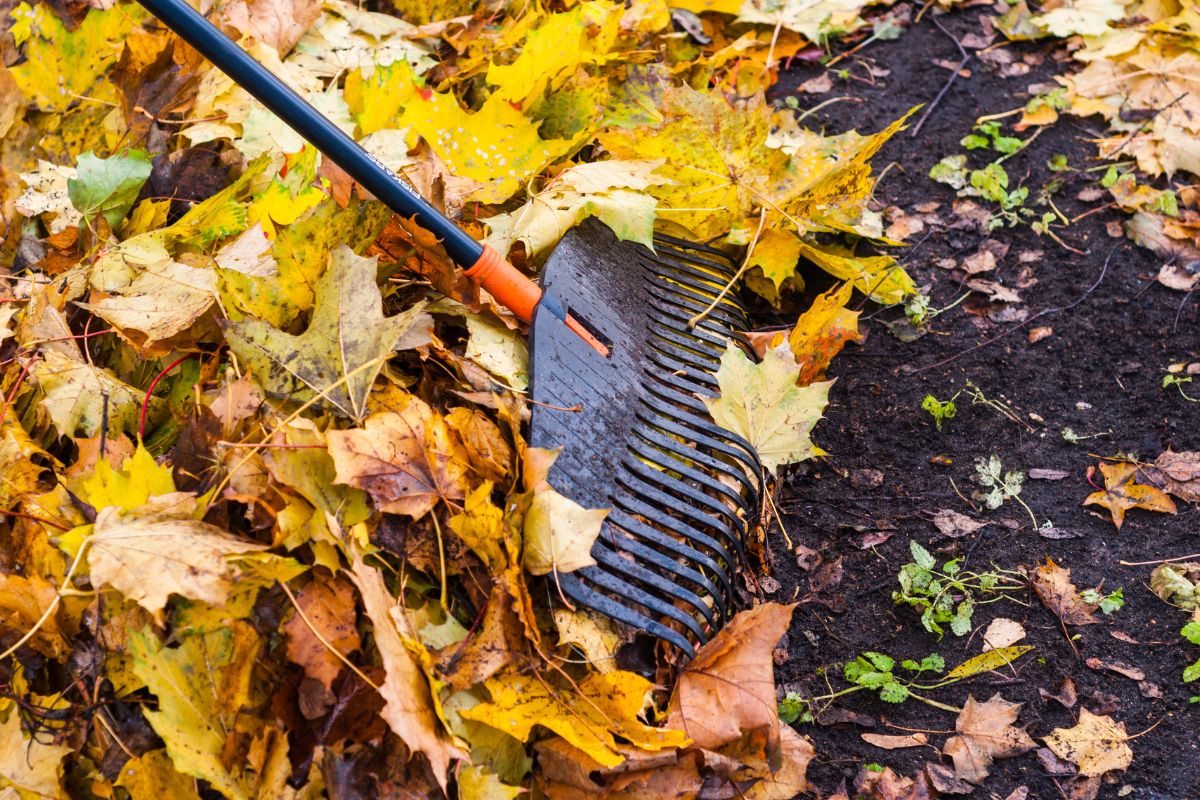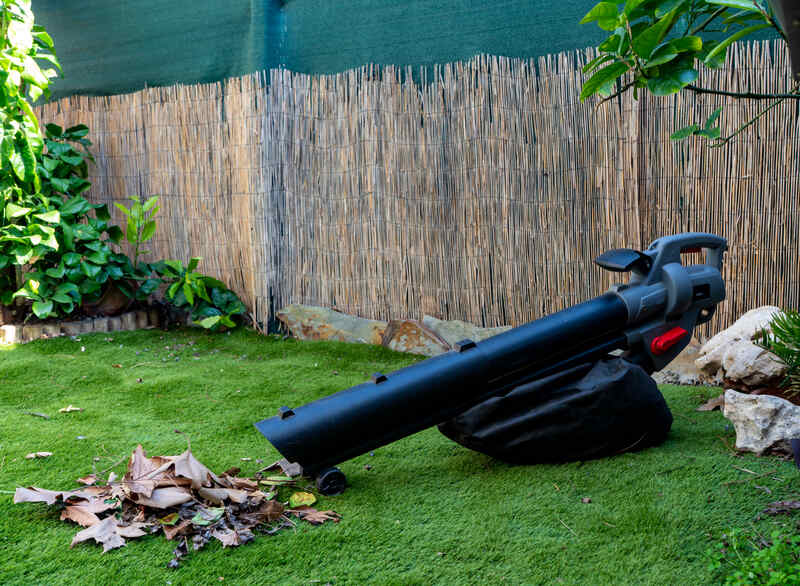
Ever tried raking wet leaves only to watch them stick to everything, including the rake? The secret lies in using the right tools and techniques to move them along.
We’ll show you how to clean up wet leaves from your yard effectively, including choosing the right leaf blower, when to consider a dethatcher, and how to decide between mulching and discharging when using a mower.
Key takeaways:
- Wear safety gear: goggles, ear protection, dust mask, gloves, work boots with deep treads to avoid slipping, long-sleeved clothing
- Mulch wet leaves or collect them on tarps. They’re sticky and harder to bag.
- Fill tarps only halfway. Wet leaves are 2-5 times heavier than dry ones.
- Wet leaves are easier to clean up in thin layers.
“The best approach for homeowners with wet leaf issues is to pick them up as soon as possible,” says Derek Washington of BRDOC Lawn Care in St. Petersburg, Florida, one of LawnStarter’s Platinum lawn care experts.
Standing wet leaves get soggy, matted, and slippery, making your job even harder. Use these tools and techniques to remove wet leaves before they turn into a big problem.
| Hire a LawnStarter leaf removal pro to tackle your wet leaf cleanup. Our customers pay an average of $158 for leaf removal and rate our professionals 4.3/5 stars. |
Powerful Leaf Blower

Can you blow wet leaves? Yes, but you’ll need more powerful equipment. Look for a leaf blower with an airspeed of at least 190 MPH and an air volume of 500 CFM or higher, like the Enhulk Pro Series 930 CFM Cordless Leaf Blower.
This combination provides sufficient force to dislodge damp, muddy leaves from grass and push them into piles.
Best for: Medium-sized to large lawns, hard-to-reach areas
Tools you’ll need:
- Leaf blower
- Tarps
- Bags (if necessary)
How to clean up wet leaves with a leaf blower:
- Keep the blower nozzle angled slightly downward.
- Go over the same area multiple times.
- Anchor the tarp corners with stones to avoid lifting its margin with your blower.
You can also “blow the wet leaves to pre-mowing areas (areas you plan to mow later) for mulching,” says Washington. But don’t leave them piled out there too long, or you’ll start having a pest problem.
“Wet leaves may create an ammonia-like smell that attracts unwanted critters,” he says.
| Pro Tip: When cleaning up wet leaves from flower beds, use the blower at a lower setting and leave behind a thin layer of leaves. It protects and feeds the soil during winter. |
See Related:
Clog-Free Rake
Have a small lawn? You can clean up the wet leaves with a rake. Damp leaves are harder to shift and pull across the lawn, so you’ll need a sturdy rake with more rigid tines and a strong handle. Look for a metal, clog-free rake that won’t skewer the leaves.
Best for: Small lawns
Tools you’ll need:
- Leaf rake
- Tarps
- Bags (if necessary)
How to clean up wet leaves with a rake:
- Work in small sections.
- Rake with short, even strokes. Wet leaves are heavier, so avoid pulling large clumps at once.
- Half-load the tarps (wet leaves are heavy), drag it to the pick-up spot, compost pile or waste bin, then do the next section.
| Pro Tip: Use a rubber rake on wooden decks, patios, and other delicate surfaces to avoid scratches. |
See Related:
- How to Rake Leaves
- 16 Tips for Cleaning Up Leaves in Your Yard
- 7 Best Leaf Rakes
- Best Ways to Clean Up Leaves in Your Yard
Mower
We all know you shouldn’t mow wet grass, but can you mow wet leaves? As long as the leaf layer is not so thick as to bog down the mower, you can mow, collect the leaves, and put them into yard waste bags or mow and mulch them on the lawn.
Best for: Medium-sized and large lawns with light leaf coverage
Tools you’ll need:
- Lawn mower
- Bags for pick-up (if necessary)
How to mow wet leaves:
- Set the blades at maximum height.
- Mow back and forth as usual (without the bag).
- Make 1-2 passes until leaf pieces are small enough to disappear into the grass.
- Leave on the lawn as mulch, or make another pass with the bag on. Unload the contents in the waste bin or compost pile.
Can you use a mulching mower? Yes, you can, but wet leaves might clog it, so check your blades and deck every 10-15 minutes for clumps if the mulching gear is on. The discharge mode may work better — it provides stronger suction to dislodge stubborn leaves that are stuck to the ground.
See Related: Is it Better to Rake or Mulch Leaves?
Leaf Vacuum

Leaf vacuums suck up the leaves, mince them into tiny pieces, and collect them in a bag. It’s fast and easy, but can you vacuum wet leaves? Because wet leaves can clog the suction tube, it’s best to use this tool only for small amounts in garden beds, corners, or under patios — not for major wet leaf cleanup.
Best for: Small areas with light leaf coverage
Tools you’ll need:
- Leaf vacuum
- Bags for pick-up (if necessary)
How to clean up wet leaves with a leaf vacuum:
- Keep the nozzle about 1 inch above the leaf layer.
- Move the nozzle side to side and back and forth.
- Empty the bag whenever it becomes heavy.
| Note: You can compost wet leaves immediately when vacuumed. They’re already shredded. |
See Related:
Power Rake or Dethatcher

Wet leaves that sit on your lawn for weeks can form a thick, soggy mat that’s difficult to rake or blow away. Use a dethatcher or a power rake to break the matted layer. These tools have rotating tines that pull up the compacted leaves from the grass, making them easier to collect.
Best for: Soggy, matted leaves that stick close to the ground
Tools you’ll need:
- Dethatcher or power rake
- Leaf collection tools (rake or blower and a tarp; bagging mower)
How to use a dethatcher on wet leaves:
- Set the height to 0 or +1/4 inches so the tines rake lightly over the soil surface.
- Walk the dethatcher over the lawn 1-2 times.
The dethatcher doesn’t collect the leaves. You’ll need to gather them on tarps with a rake or a leaf blower and carry them to the curb or your compost bin. Or run your mower over the lawn with the bag on and the blades at the maximum height to collect the debris.
See Related:
FAQ
Wait at least a few hours after rain to allow some of the water to dry out from the leaves. Soaked leaves are harder to clean than damp leaves.
The best bags for heavy, wet leaves are heavy-duty reusable garden waste bags or 2-ply wet-strength paper bags. These paper bags use resin bonding between layers for water and tear resistance.
Wet leaves won’t kill your grass if you leave them for a week, but the humid coverage increases the risk of fungal infections and can lead to discolored grass because it blocks the sunlight.
Leave the Hard Work to a Professional
Tired of wrestling with stubborn wet leaves? LawnStarter pros have the right equipment and expertise to clear your entire yard in a fraction of the time. Find a LawnStarter leaf removal pro and get your yard cleared without the backache.
Sources:
- Derek Washington, lawn care expert, BRDOC Lawn Care, St. Petersburg, FL. Personal interview.
- “Mulch Mowing Fall Leaves.” Kansas State University.
- “Yard and Garden: Managing Fallen Leaves.” By Aaron J. Steil, consumer horticulture Extension specialist. Iowa State University.
Main Image: Use a rake to remove wet leaves. Photo Credit: artursfoto / Adobe Stock